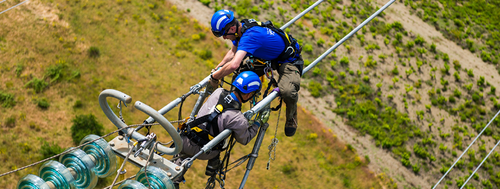Tower Climbing with Petzl
PETZL Professional safety gear is constantly in high demand. As a result, their equipment rarely goes on sale. For a limited time, save 25% on Petzl products from August 26th through September 8th only at PK Safety. Sale prices are reflected on PKSafety.com and don't require a discount code.
All around the world, energy and network towers exist need servicing by tower climbers. Some types of projects these climbers work on include antenna installation, changing light bulbs and routine inspections. The job can vary greatly and be very demanding, especially when hauling tools and materials.
Tower climbers face inherent risks such as falling objects, structural collapses and equipment failures. Some of the more frequently encountered hazards include falls from great heights, electrical hazards, inclement weather, falling object hazards, equipment failure, and structural collapse of towers. To mitigate these hazards climbers use personal protective equipment (PPE) along with climbing equipment.
To protect against falls, each worker must use a fall arrest system. When building a fall arrest system, start with the harness that's going to support you while you work or catch you if you fall. Also include a 100 percent tie-off shock-absorbing lanyard with a mobile fall arrester. A positioning lanyard, though not required, can also help with staying stationary instead of swinging while working. You'll also need carabiners for connecting the harness and lanyards. Also consider rappel gloves for better handling and avoiding rope burn.
In addition to the equipment that keeps us safe from falling, there's also headgear to keep workers safe from falling objects and head injuries. Falling objects may include loose debris, tools, or dropped objects from other workers. The Vertex and Alveo helmets are popular. If you'll be wearing eye protection too, consider leaving the safety glasses at home and opt for the Vizir faceshield for Vertex and Alveo helmets. It attaches to the user's helmet and swivels up and down.
When working on or around energized facilities, climbers will also need arc flash rated clothingand equipment if the system can't be deenergized. Refer to our arc flash blog post for more information about the changing regulations and consult your company safety professional for training.
The equipment suggestions in this article aren't to be substituted for training safety on climbing techniques. The ability of the climber to thoroughly risk assess and plan the climb is vital. Equipment selection is only one stage of the job in addition to safe access, secure positioning and emergency planning. Questions? Give us a call at 1-800-829-9580.
Recent Posts
-
Promoting Safety: National Work Zone Awareness Week is April 15-19, 2024
Each year, the National Work Zone Awareness Week (NWZAW) places the spotlight on the importance o …Apr 11th 2024 -
Understanding 4 Gas Monitors: How They Work & Why They Are Important
In today’s increasingly dynamic industrial landscape, 4 gas monitors have emerged as critical com …Apr 8th 2024 -
April Showers Require Workers to Wear Hi-Vis Safety Rain Gear
While April showers bring May flowers, they also bring challenges, particularly for those working …Apr 1st 2024





